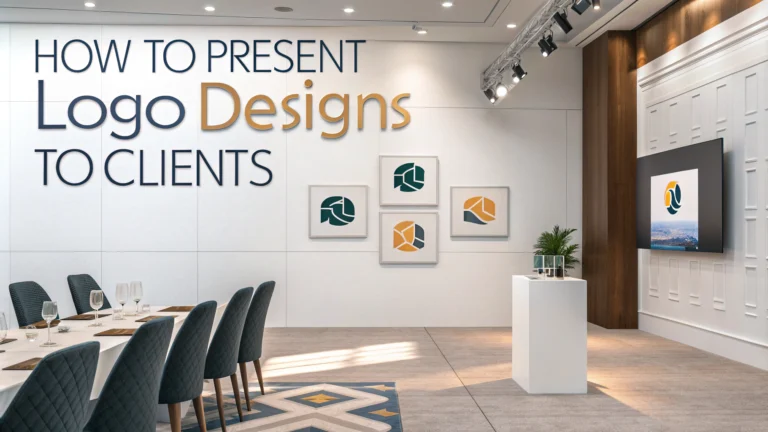Presenting logo designs effectively can make the difference between winning client approval and going back to the drawing board.
This guide shows proven methods to present your logo designs professionally and increase your chances of client acceptance.
Preparation Before the Presentation
- Create a clean, professional presentation template
- Prepare 3-5 strong concepts (avoid overwhelming with too many options)
- Design mockups showing real-world applications
- Write clear explanations for your design choices
Essential Elements to Include
Each logo presentation should contain these key components:
- Logo in full color, black, and white versions
- Mockups showing the logo on business cards, signage, and digital platforms
- Brief rationale explaining your design decisions
- Technical specifications (colors, fonts, spacing)
Presentation Methods
- In-Person Meetings: Bring printed materials and digital presentations
- Video Calls: Use screen sharing with high-quality PDFs
- Email: Send professional PDF presentations with clear instructions
Practical Tips for Success
- Present strongest concepts first
- Show logos in context with realistic mockups
- Explain how each design aligns with business goals
- Present one concept at a time to avoid overwhelming
- Be prepared for questions and feedback
Common Presentation Tools
- Adobe InDesign for PDF presentations
- Mockup tools like Smartmockups or PlaceIt
- Video conferencing software (Zoom, Google Meet)
- Cloud sharing platforms (Dropbox, Google Drive)
Handling Feedback
- Listen actively to client comments
- Take detailed notes during the presentation
- Ask specific questions about their preferences
- Establish clear next steps and revision processes
Contact professional design organizations like AIGA (www.aiga.org) for additional resources and guidance on client presentations.
Post-Presentation Steps
- Send a follow-up email summarizing key points
- Document all feedback received
- Set clear timelines for revisions
- Prepare invoice and contract documents
| Do | Don’t |
|---|---|
| Present professionally | Show unfinished work |
| Explain your rationale | Apologize for designs |
| Listen to feedback | Argue with clients |
| Show realistic mockups | Present too many options |
Client Communication Strategies
- Use clear, professional language
- Focus on business benefits rather than design jargon
- Maintain confident body language during presentations
- Practice active listening when receiving feedback
Building Long-term Relationships
Follow-up Care
- Schedule check-ins after project completion
- Provide logo usage guidelines document
- Offer support for technical implementation
- Request testimonials and referrals
Additional Services
- Suggest brand extension opportunities
- Offer maintenance packages
- Provide training for internal teams
- Recommend complementary design services
Conclusion
Successful logo presentations require thorough preparation, professional delivery, and strategic follow-up. By following these guidelines, designers can:
- Increase client approval rates
- Build stronger professional relationships
- Streamline the revision process
- Create opportunities for future projects
Remember that presentation skills are just as important as design skills in achieving client satisfaction and building a successful design practice.
| Key Takeaway | Action Item |
|---|---|
| Professional presentation | Create presentation templates |
| Clear communication | Develop presentation script |
| Client relationship | Plan follow-up strategy |
FAQs
- How many logo design concepts should I present to a client?
Usually present 3-5 strong logo concepts. This provides enough variety without overwhelming the client, while ensuring each design is well-thought-out and purposeful. - What’s the best format to present logo designs to clients?
Present logos in PDF format showing multiple applications including mockups on business cards, signage, and digital platforms. Include both color and monochrome versions. - Should I explain the design rationale for each logo concept?
Yes, provide a brief explanation for each design, including the thought process, symbolism, and how it aligns with the client’s brand values and target audience. - Is it necessary to show how the logo looks in different sizes?
Yes, demonstrate logo scalability by showing how it appears in various sizes, from very small (favicon size) to large format applications, to prove its versatility. - How should I handle color variations in logo presentations?
Show the primary color version first, followed by black and white versions, reversed options, and any approved brand color variations. Include color codes (CMYK, RGB, HEX) for reference. - What’s the best way to present logo designs remotely?
Use professional presentation tools like InVision or Adobe XD for interactive presentations, or create a detailed PDF with real-world mockups. Schedule a video call for live presentation. - Should I show clients the logo design process and iterations?
Only show polished, final concepts. Showing work-in-progress or too many iterations can confuse clients and diminish the impact of your final designs. - How do I present logo typography choices?
Include font names, showcase how typography works in various applications, and explain why specific fonts were chosen to match brand personality. - What should I include in the logo usage guidelines presentation?
Present clear spacing rules, minimum size requirements, approved color variations, forbidden modifications, and acceptable background usage scenarios. - How do I handle client revision requests during the presentation?
Take detailed notes of feedback, clarify specific concerns, and establish clear boundaries about the number of revision rounds included in the project scope.







